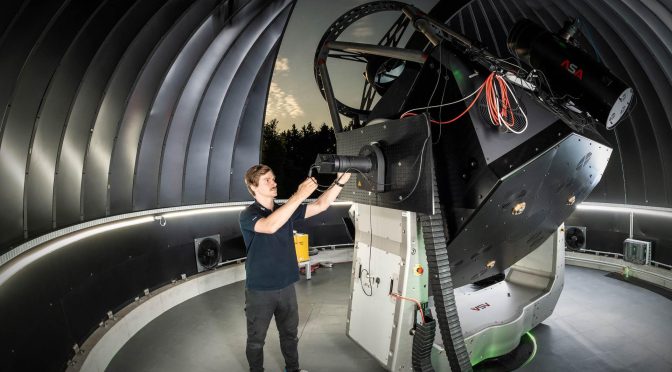With the Johannes Kepler Observatory, the German Aerospace Center (Deutsches Zentrum fuer Luft- und Raumfahrt; DLR) has a unique research and development station. The observatory will use state-of-the-art laser technology to determine the trajectory and composition of space debris in near-Earth orbit as quickly, precisely and reliably as possible. This information helps, for example, to protect active satellites from collisions with space debris by enabling evasive manoeuvres to be planned more efficiently. After roughly two years of construction and commissioning, DLR officially inaugurated the observatory on 20 July 2022 together with guests from politics, administration, industry and science. The observatory is located on the Empfingen innovation campus, approximately 60 kilometres southwest of Stuttgart. The DLR Institute of Technical Physics, whose central research facilities include the observatory, is also located there.
Enabling satellite and space missions in the future – despite space debris
“Whether for information, communications or navigation, satellite technologies have become an indispensable part of modern business, science and society. But the space above Earth is becoming more and more crowded and space debris is an increasing problem. As such, DLR is already working on technological solutions for greater safety in space. DLR’s Johannes Kepler Observatory will play a central role in this,” explains Anke Kaysser-Pyzalla, Chair of the DLR Executive Board.
“Spaceflight is fascination. It is the urge to discover and the origin of knowledge, innovation and new technology that improves life on Earth. Preserving the possibilities of spaceflight for future generations is a mission that Germany is embarking on with partners in Europe and around the world. DLR’s Johannes Kepler Observatory is an important part of this. As a unique research platform for observing and evaluating objects in Earth orbit, it will allow us to continue the safe operation of satellites in the future and the successful deployment of robotic and astronautical missions,” says Anna Christmann, Federal Government Coordinator for German Aerospace Policy.
DLR research telescope is the largest of its kind in Europe
The telescope at the Johannes Kepler Observatory is the largest of its kind in Europe for observing and characterising objects in Earth orbit. The primary mirror has a diameter of 1.75 metres. The telescope is housed in an almost 15-metre-tall round tower with a rotating slotted dome. It rotates synchronously with the telescope and opens only for about two metres in the respective viewing direction. The dome is mounted on rollers and driven by a motor. The telescope can be rotated at up to six degrees per second. This high ‘tracking speed’ in combination with the large primary mirror is a technological challenge. However, both are necessary to view the largest possible area of the sky and to be able to simultaneously detect, locate and characterise objects up to 10 centimetres across and moving at 28,000 kilometres per hour.
The focus of the research and development work of the team from the DLR Institute of Technical Physics is on high-precision distance measurement using special lasers. In addition, the DLR researchers want to locate previously unknown objects in Earth orbit. To do this, they carry out spectral analyses – they examine the colour composition of the sunlight scattered by the observed objects. In this way, they can draw conclusions, for example, about what kind of object it is, what material it is made of, how big it is, how it rotates and its orbit.
Co-founder of modern astronomy as eponym
Johannes Kepler is regarded as the co-founder of modern astronomy and modern natural sciences. He formulated the laws to describe how the planets orbit the Sun: in an elliptical orbit with the Sun at a focal point of the planet’s orbit. Johannes Kepler spent his childhood and youth in the southwest of Germany.
The investment of around 2.5 million euros comes from funds provided by DLR and the German Federal Ministry for Economic Affairs and Climate Action (BMWK). The research work contributes to the safe use of space. It is supported by the Security Programme Coordination organisation at DLR with funds from the Federal Ministry of Defence (BMVg).


